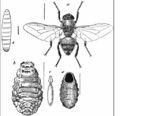Hypoderma spp.
Also known as: Warble Flies
Introduction
This is a fly of the family Oestridae, which parasitises animals. There are two important Hypoderma spp. found in cattle, namely; H. bovis and H. lineatum. H. diana is also a parasite of clinical significance, affecting the deer population. Hypoderma species are also known as 'warble flies'. The parasite is found in the northern hemisphere in Europe, America and some of Africa. Both cattle species have been eradicated from the UK, but H. diana still exists. The disease is notifiable.
H. bovis is around 15mm in length and has a bumble-bee appearance. The abdomen is yellow and there is a band of black hairs located around the middle. H. bovis lays single eggs on hairs around the lower legs of the host. The larvae develop and enter the body through the skin, where they migrate to the epidural fat found along the thoracic and lumbar vertebrae of the spine. The larvae stay here for the duration of the winter. The larvae are palpable as distinct swellings, known as warbles.
H. lineatum are around 13mm in length, and like H. bovis have a bee-like appearance. The eggs are laid in rows of around 6 on single hairs. The eggs then penetrate the skin and move along the connective tissue toward the diaphragm. They will continue to migrate, until they reach the oesophagus where the larvae will spend the duration of the winter. After 3 months larvae reach winter resting sites where they remain from November to February/March whilst moulting to the L2 stage.
Adult flies emerge on warm, sunny days between June and August. The adult lives for around 3 weeks.
H. diana is around 15mm in length. The adults have a short life-span, and do not feed. Eggs are laid on the legs and lower body of the host. Larvae crawl down the hairs, and begin migration through the skin. The larvae burrow along the spinal cord, and spend the winter in the epidural fat of the spine around the thoracic and lumbar region. The migration is then initiated in the spring and warbles then begin to form along the back of the host.
Clinical Signs
There may be no clinical signs until after slaughter when the hide will have holes in and will be condemned and down-graded. There will usually be seen a reduced milk yield and reduced weight gain. There may also be injury from stock panic when the cattle can hear the characteristic noise of the warble fly. There may also be trimmed meat losses from H. lineatum as 'Butcher's Jelly' around warbles is green due to mass eosinophil attraction.
In severe cases, paraplegia resulting from toxin release and pressure on the spinal cord (H. bovis) can occur. This is most common when the larvae are killed in their winter resting sites. In a H. lineatum infection bloat may ensue, due to pressure on the oesophageal wall.
Diagnosis
Usually not discovered until post mortem examination. If they are known to exist in the area, close examination of the back of cattle may reveal signs of them in their breathing holes.
Control
Total eradication should be aimed for and timing is crucial for treatment. Larvae residing in winter resting sites can lead to bloat and paraplegia if killed. It is safe to treat in the autumn before larvae reach their winter resting sites and in the spring when the warbles have migrated to the midline of the back. Ivermectin can be given at any time without risking host infection as larval antigen is released much slower. Systemic organophosphorus insecticides in pour-on formula and avermectins and milbemycins in pour-on and injectable formulations can be used for this.
Old methods include popping out warbles, but this can lead to anaphylactic shock.
Other Information
Legislation in the UK:
- 'Warble Fly Order 1978' requires all clinically affected animals to be treated
- 'Warble Fly Infected Area Order 1983'- Notifiable disease
| Hypoderma spp. Learning Resources | |
|---|---|
To reach the Vetstream content, please select |
Canis, Felis, Lapis or Equis |
 Test your knowledge using flashcard type questions |
Myiasis Producing Flies Flashcards |
 Search for recent publications via CAB Abstract (CABI log in required) |
Hypoderma spp. publications |
References
Andrews, A.H, Blowey, R.W, Boyd, H and Eddy, R.G. (2004) Bovine Medicine (Second edition), Blackwell Publishing
Blood, D.C. and Studdert, V. P. (1999) Saunders Comprehensive Veterinary Dictionary (2nd Edition) Elsevier Science
Divers, T.J. and Peek, S.F. (2008) Rebhun's diseases of dairy cattle Elsevier Health Scieneces
Fox, M and Jacobs, D. (2007) Parasitology Study Guide Part 1: Ectoparasites Royal Veterinary College
Merck & Co (2008) The Merck Veterinary Manual (Eighth Edition) Merial
Radostits, O.M, Arundel, J.H, and Gay, C.C. (2000) Veterinary Medicine: a textbook of the diseases of cattle, sheep, pigs, goats and horses Elsevier Health Sciences
| This article has been peer reviewed but is awaiting expert review. If you would like to help with this, please see more information about expert reviewing. |
Error in widget FBRecommend: unable to write file /var/www/wikivet.net/extensions/Widgets/compiled_templates/wrt695e04cdb4b883_23825386 Error in widget google+: unable to write file /var/www/wikivet.net/extensions/Widgets/compiled_templates/wrt695e04cdbb9048_12888644 Error in widget TwitterTweet: unable to write file /var/www/wikivet.net/extensions/Widgets/compiled_templates/wrt695e04cdc21c08_84203271
|
| WikiVet® Introduction - Help WikiVet - Report a Problem |
